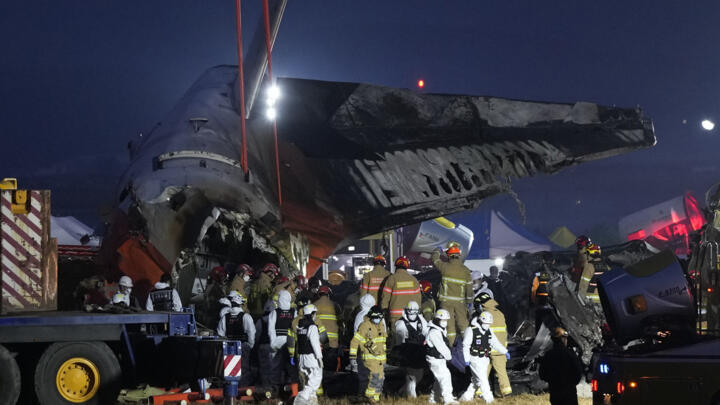
The worst domestic crash killed 179 people, prompting South Korea to seek an aviation safety review
In an effort to identify victims and determine the cause of the deadliest air accident to occur on South Korean soil, acting President Choi Sang-mok of South Korea ordered an immediate safety inspection of the nation’s entire airline business on Monday.
Upon opening a new tab, a Jeju Air (089590.KS) killed all 175 passengers and four of the six crew members. Boeing (BA.N.) launches a new tab A 737-800 crashed into a wall at Muan International Airport after belly-landing and skidding off the end of the runway, exploding in a blaze. They hauled out two crew members alive.
Choi told a disaster management meeting in Seoul that the two survivors’ treatment, victim identification, and family support are currently the top priorities.
“Even before the final results are out, we ask that officials transparently disclose the accident investigation process and promptly inform the bereaved families,” he continued.
“As soon as the accident recovery is conducted, the transport ministry is requested to conduct an emergency safety inspection of the entire aircraft operation system to prevent recurrence of aircraft accidents,” stated the minister.
The transport ministry first declared that, starting Monday, it would do a special assessment of all 101 Boeing 737-800 aircraft flown by South Korean airlines, with an emphasis on the maintenance history of critical parts.
Shortly after 9 a.m. (0000 GMT) on Sunday, Jeju Air aircraft 7C2216, which was heading to the southern airport from Bangkok, Thailand, was attempting to touch down.
According to transportation and fire officials, investigators are looking into the pilots’ apparent haste to try a landing shortly after announcing an emergency, whether any of the aircraft’s control systems were turned off, and bird strikes as potential causes of the disaster.
When the plane went down the runway and struck a concrete embankment, experts say there are still a lot of unanswered concerns, such as why the two CFM 56-7B26 engines seemed to be driving so quickly and why the landing gear did not appear to be down.
A joint company between France’s Safran (SAF.PA) and GE Aerospace (GE.N) is called CFM International.
As the pilots made their planned approach on Monday, they informed air traffic control that the aircraft had been struck by birds. Shortly after the control tower alerted them to the presence of birds nearby, the pilots reported the incident, according to transport ministry authorities.
The pilots then signaled that they were going to abandon the landing and go around and try again, issuing a Mayday notice. A belly landing was made shortly after, with the plane touching down around 1,200 meters (1,310 yards) along the 2,800-meter (3,062-yard) runway and rolling into the slope at the end of the landing strip.
“You’re without a wall.”
At a media briefing, authorities from the transport ministry stated that they are looking into the role that the localizer antenna, which was placed at the end of the runway to aid in landing, and the concrete embankment it was situated on played in the collision.
The Munich-based Lufthansa pilot and flight safety specialist Christian Beckert stated, “Normally, on an airport with a runway at the end, you don’t have a wall.” “You more have maybe an engineered material arresting system, which lets the airplane sink into the ground a little bit and brakes (it).”
Two Thai nationals and primarily locals coming from vacation in Thailand perished in the disaster.
According to Boonchuay Duangmanee, 77, the father of one of the Thai victims, “I can only accept it, make peace with it.” It was an accident, I remind myself when I consider it. Anyone could experience this. My daughter will never return, no matter what I do, therefore I’ve accepted that fact.”
Inside the airport terminal in Muan, distraught family waited Monday morning as investigators attempted to identify some of the more than two dozen victims who were still alive.
Despite not being able to view his brother’s body, Park Han-shin, who lost his brother in the collision, claimed that authorities informed him that his brother had been recognized.
In reference to a 2014 ferry catastrophe that claimed over 300 lives, Park urged the relatives of the victims to work together in the wake of the tragedy. Authorities waited too long to identify the people killed and the cause of the Sewol ferry catastrophe, according to numerous relatives of the dead.
According to officials from the transportation ministry, the jet’s flight data recorder was found, but it looked to have some external damage, and it was unclear at this time if the data was still intact enough to be analyzed.
The U.S. National Transportation Safety Board (NTSB) and Boeing officials told reporters that the recorder has been shipped to Seoul and that an analysis will start when they arrive late Monday.
While the main Incheon International Airport and other international and regional airports in South Korea were functioning as planned, Muan International Airport remained closed until Wednesday.
Jeju Air’s stock fell as much as 15.7% on Monday, the lowest level ever recorded. In pre-market trade, Boeing’s shares listed in the United States were down 4.3%.
South Korea will take the lead in a civil investigation into the crash, and since the jet was developed and manufactured in the United States, the NTSB will be automatically involved under international aviation regulations.
About 9 kilometers (5 miles) from the crash scene, a sizable memorial has been erected in a county gym, where people, including acting President Choi, have come to offer their respects.
Choi took over as interim leader three days ago after the country’s president and prime minister were impeached for imposing a temporary martial law. Choi is in charge of the investigation and recovery operations.
Marcos Alvarez, managing director of global insurance ratings at Morningstar DBRS, estimates that the aviation insurance industry may face a claim of $15–$20 million under the airline hull insurance policy and a total of $120–$180 million in passenger liability claims for the incident.
All Categories
Recent Posts
Tags
+13162306000
zoneyetu@yahoo.com



